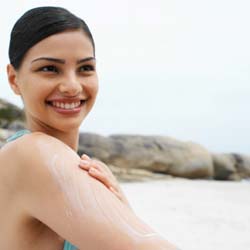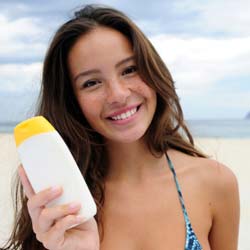I am part dermatologist, part broken record.
“Wear your sunscreen” is a mantra I repeat endlessly throughout the day. I even once remember saying it Spanish in a dream when I was learning the language. Most people just nod their head politely and go right outside into the sun without a second thought to my words of warning. But I do have patients give me their rebuttals from time to time. I want to share with you some of my favorites.
Have these words crossed your lips?

“Getting a base tan before a vacation protects your skin.”
It depends on what you mean by “protect”. Having a base tan may keep you from burning as quickly as you normally would, but does not protect you from the carcinogenic and wrinkle-inducing effects of sunlight. Any time your skin is tan, you have induced damage to your cell’s DNA. If you are concerned about blinding people with pasty white skin at the beach, it makes more sense to use a sunless tanner before you go rather than a tanning booth. Of course when you get to the beach, aggressive and liberal application of sunscreen is the recommendation.
“Sunless tanner is as safe as sunscreen.”
Sunless tanners, spray tans, or “bronzers” contain a chemical called dihydroxyacetone. They afford you the SPF of approximately 2-3. Several years ago these agents turned skin a sickly shade of orange. Newer products are more cosmetically elegant and don’t give you the unfashionable jaundiced look. Remember, they do not give you adequate protection from the sun regardless of how dark you get.
“Tanning is the best way to boost my vitamin D levels.”
Tanning will elevate your measurable levels of vitamin D without a doubt. I fail to see the logic in soaking your body in cancer-inducing ultraviolet radiation to get a vitamin you can take orally.

“It is a cloudy day so I don’t need sunscreen.”
Who has not been to the beach and gotten burnt on a cloudy day? The spectrum of radiation emitted by the sun is vast and visible light is only a tiny fraction of it. The ultraviolet rays have nothing to do with visible light, they are invisible. In fact when it is cloudy only the infrared, heat-generating rays are blocked; ultraviolet radiation goes right through clouds.
“I am addicted to tanning”
This may be true. Researchers have found that the chemical proopiomelanocortin is released from the pituitary in response to tanning. Although a horrible mouthful to pronounce, it contains several key constituents in its name. “Opio” is short for opiod, as in opium. It is our body’s endogenous feel good, groovy molecule and pain killer. The “melano” refers to melanin which our skin cells make in response to this hormone. So it is not surprising that some people get a mild high from tanning, as the brain simultaneously releases the two chemicals at once in response to enough ultraviolet light. There are even studies documenting self-described tanning addicts going through withdraw symptoms when deprived of their tanning.
There is ultimately little I can do to change people’s beliefs and behavior. Hopefully by dispelling a few of these myths it will cause someone to practice a little extra sun safety.
If your skin has been damaged by the sun, there are a variety of treatment options to help give you healthier, younger looking skin. Click here to request a free consultation.

